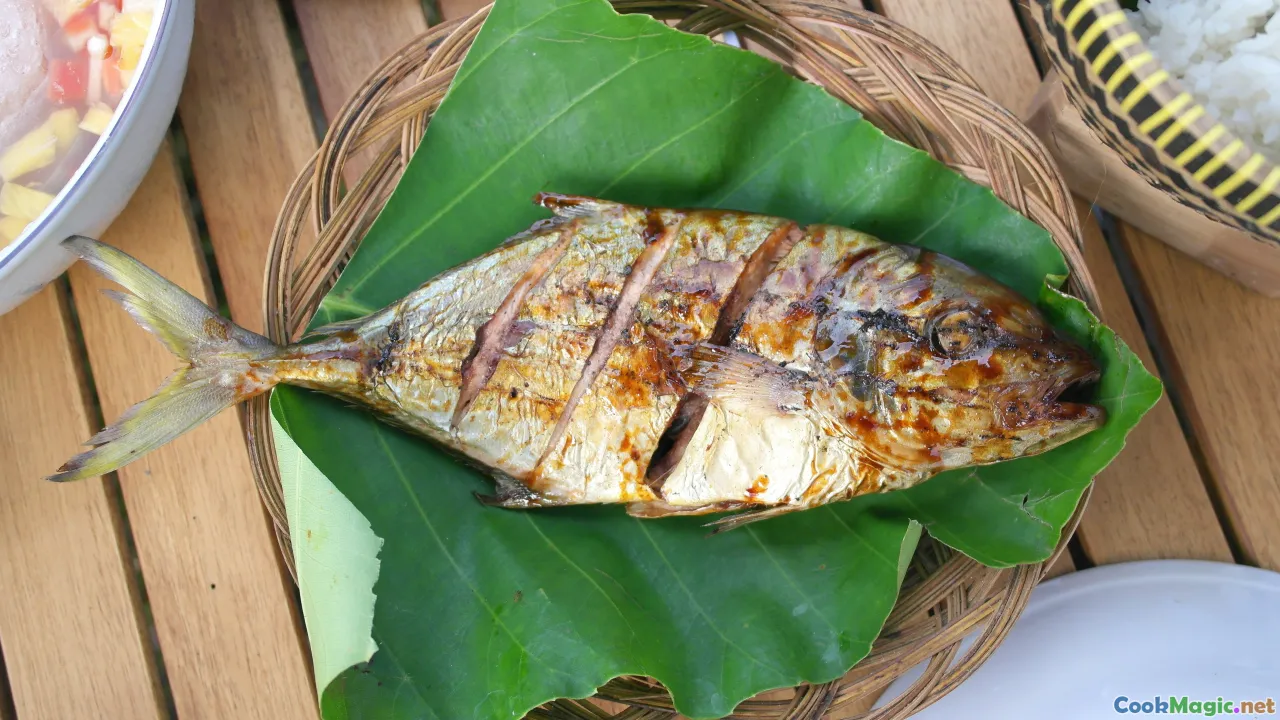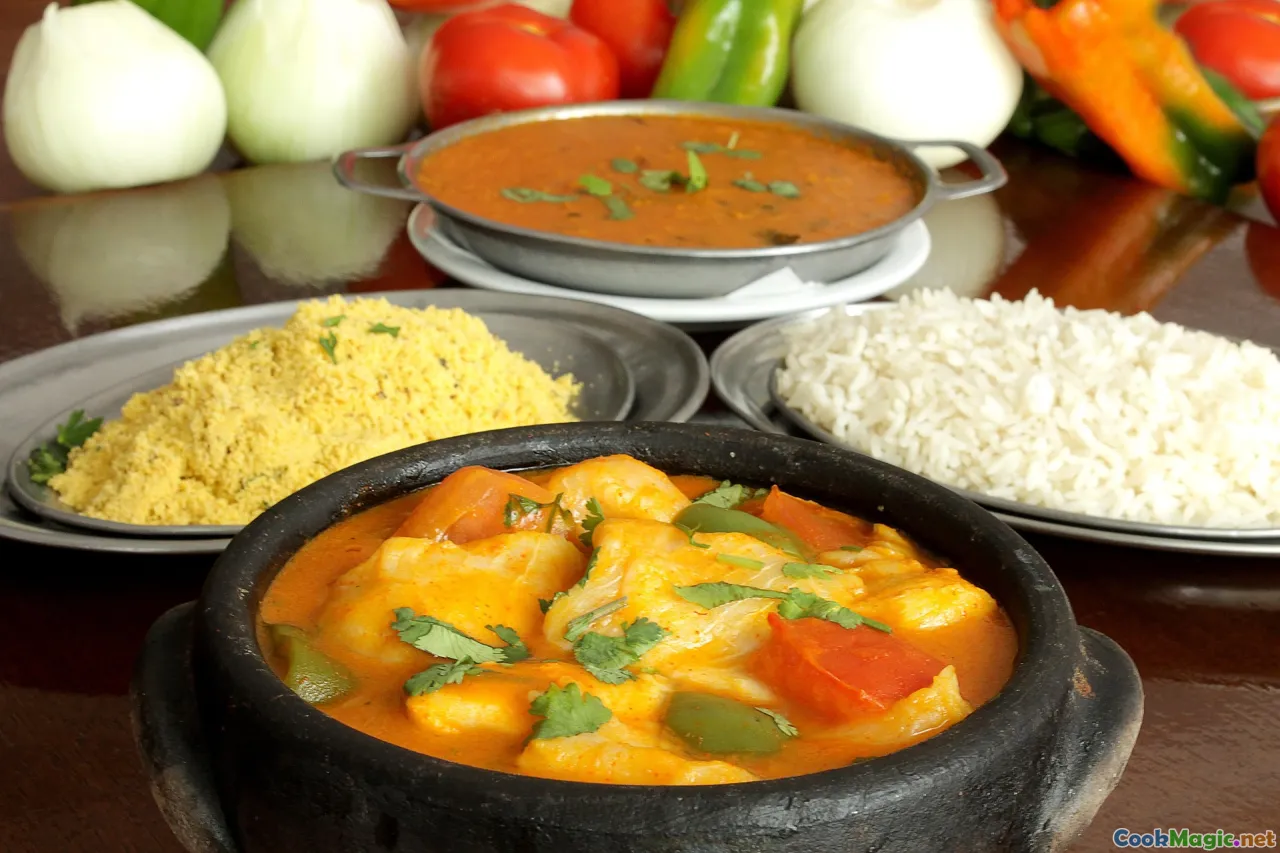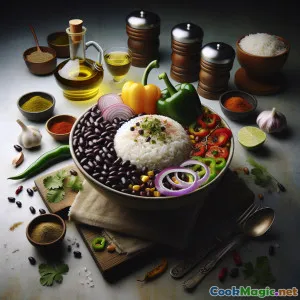
Costa Rican Coconut Fish Rondón Stew
(0 Reviews)
Servings
Serving Size
Prep Time
Cook Time
Total Time
Categories
Country
Cuisines
Level
Votes
0
0
Page views
354
354
Update
October 07, 2025
October 07, 2025
Report
Report a Problem
Report a Problem
Ingredients
-
800 grams Firm white fish fillets (snapper, mahi-mahi, or grouper)
(Cut into 5 cm chunks; sustainably sourced if possible)
-
800 ml Coconut milk (full-fat)
(About 2 cans; shake well)
-
500 ml Fish stock (or water)
(Use low-sodium stock to control seasoning)
-
1 large Green plantain
(Peeled and cut into 1 cm slices)
-
300 grams Cassava (yuca), peeled and chunked
(Remove woody core; rinse well)
-
250 grams Sweet potato, peeled and chunked
(Orange-fleshed preferred)
-
1 medium Chayote squash, diced
(Can substitute zucchini)
-
1 ear Corn on the cob, cut into 3–4 rounds
(Fresh or parboiled)
-
1 medium Red bell pepper, sliced
(Adds sweetness and color)
-
1 medium Yellow onion, diced
(White onion also works)
-
4 cloves Garlic (minced)
(Freshly minced for best aroma)
-
4 sprigs Fresh thyme sprigs
(Use leaves if stems are tough)
-
2 tbsp Culantro (or cilantro), chopped
(Culantro is traditional; cilantro is fine)
-
1 small Scotch bonnet or habanero chili, whole and pierced
(Leave whole for gentle heat; remove before serving)
-
1 tsp Ground allspice (pimento)
(Signature Caribbean warmth)
-
1 tsp Fresh ginger, grated
(Brightens the coconut base)
-
1 piece Lime (zest and juice)
(Zest for marinade, juice to finish)
-
1 tbsp Coconut oil
(For sautéing aromatics)
-
1 tsp Achiote (annatto) oil or paste
(Adds earthy color; optional)
-
2 tsp Kosher salt
(Adjust to taste)
-
0.5 tsp Black pepper
(Freshly ground)
-
2 stalks Green onions (scallions), chopped
(For finishing and garnish)
-
2 tbsp Fresh parsley or extra cilantro, chopped
(Garnish)
(Cut into 5 cm chunks; sustainably sourced if possible)
(About 2 cans; shake well)
(Use low-sodium stock to control seasoning)
(Peeled and cut into 1 cm slices)
(Remove woody core; rinse well)
(Orange-fleshed preferred)
(Can substitute zucchini)
(Fresh or parboiled)
(Adds sweetness and color)
(White onion also works)
(Freshly minced for best aroma)
(Use leaves if stems are tough)
(Culantro is traditional; cilantro is fine)
(Leave whole for gentle heat; remove before serving)
(Signature Caribbean warmth)
(Brightens the coconut base)
(Zest for marinade, juice to finish)
(For sautéing aromatics)
(Adds earthy color; optional)
(Adjust to taste)
(Freshly ground)
(For finishing and garnish)
(Garnish)
Nutrition
- Servings: 4
- Serving Size: 1 bowl (350g)
- Calories: 620 kcal
- Carbohydrates: 55 g
- Protein: 38 g
- Fat: 28 g
- Fiber: 9 g
- Sugar: 8 g
- Sodium: 900 mg
- Cholesterol: 85 mg
- Calcium: 120 mg
- Iron: 3.2 mg
Instructions
-
1 - Marinate the Fish:
Pat fish dry. Toss with lime zest, half the lime juice, 1 tsp salt, black pepper, ginger, half the garlic, and a few thyme leaves. Set aside while you prep.
-
2 - Prep the roots and vegetables:
Peel plantain and slice. Peel cassava, remove woody core, cut into chunks. Dice sweet potato and chayote. Slice bell pepper, dice onion, and chop herbs.
-
3 - Sauté Aromatics:
Warm coconut oil in a large heavy pot over medium heat. Add achiote (if using), onion, bell pepper, remaining garlic, and thyme sprigs. Cook until translucent and fragrant.
-
4 - Build the coconut broth:
Pour in coconut milk and fish stock. Stir in allspice and a pinch of salt. Bring to a gentle simmer.
-
5 - Cook the hearty vegetables:
Add cassava, sweet potato, corn rounds, and plantain. Nestle the pierced Scotch bonnet on top. Simmer gently until just tender.
-
6 - Season and Adjust:
Taste the broth. Add more salt if needed. If it’s too rich, add a splash of water; if thin, simmer uncovered to reduce slightly.
-
7 - Add fish and chayote:
Gently slide in the marinated fish and chayote. Simmer just until the fish flakes easily and is opaque. Avoid stirring vigorously to keep pieces intact.
-
8 - Finish with herbs and lime:
Remove the whole chili. Stir in chopped culantro (or cilantro), green onions, and remaining lime juice. Adjust salt and pepper.
-
9 - Rest and Serve:
Turn off heat and let stew rest for a few minutes to settle. Ladle into warm bowls, ensuring each serving has fish, plantain, and roots.
-
10 - Garnish and accompany:
Top with parsley or extra cilantro. Serve with white rice, patacones, or a simple cabbage slaw.
Pat fish dry. Toss with lime zest, half the lime juice, 1 tsp salt, black pepper, ginger, half the garlic, and a few thyme leaves. Set aside while you prep.
Peel plantain and slice. Peel cassava, remove woody core, cut into chunks. Dice sweet potato and chayote. Slice bell pepper, dice onion, and chop herbs.
Warm coconut oil in a large heavy pot over medium heat. Add achiote (if using), onion, bell pepper, remaining garlic, and thyme sprigs. Cook until translucent and fragrant.
Pour in coconut milk and fish stock. Stir in allspice and a pinch of salt. Bring to a gentle simmer.
Add cassava, sweet potato, corn rounds, and plantain. Nestle the pierced Scotch bonnet on top. Simmer gently until just tender.
Taste the broth. Add more salt if needed. If it’s too rich, add a splash of water; if thin, simmer uncovered to reduce slightly.
Gently slide in the marinated fish and chayote. Simmer just until the fish flakes easily and is opaque. Avoid stirring vigorously to keep pieces intact.
Remove the whole chili. Stir in chopped culantro (or cilantro), green onions, and remaining lime juice. Adjust salt and pepper.
Turn off heat and let stew rest for a few minutes to settle. Ladle into warm bowls, ensuring each serving has fish, plantain, and roots.
Top with parsley or extra cilantro. Serve with white rice, patacones, or a simple cabbage slaw.
More About: Costa Rican Coconut Fish Rondón Stew
A soulful Costa Rican Caribbean fish stew simmered in coconut milk with plantain, cassava, and herbs for seaside comfort in one pot.
What is Rondón Tico de Pescado?\nRondón is a beloved coastal stew from Costa Rica’s Caribbean province of Limón, a cousin to the Jamaican “run down.” The dish celebrates the region’s Afro-Caribbean heritage, harnessing the lush richness of coconut milk, the comfort of starchy “ground provisions” (known locally as viandas), and the bright snap of fresh herbs and a whole Scotch bonnet pepper. Rondón Tico de Pescado centers fish, gently poached in a creamy, aromatic broth along with plantain, cassava, and sweet potato. The magic lies in the balance—silky coconut, earthy roots, a kiss of heat, and citrusy lift.\n\n## Key Characteristics\n- Coconut-forward broth: Full-fat coconut milk simmers into a velvety base.\n- Breadkind roots: Cassava, sweet potato, plantain, and sometimes yampi or malanga add body and soul.\n- Gentle heat: A whole pierced Scotch bonnet infuses perfume without overwhelming spice.\n- One-pot ease: Layers build in a single heavy pot, ideal for family meals.\n\n## Ingredient Spotlight\n- Fish: Firm, sustainable white fish like snapper, corvina, or mahi-mahi holds its shape in the stew. Cut into generous chunks to prevent overcooking.\n- Coconut milk: Choose full-fat for authenticity and texture. Shake the can to evenly distribute cream.\n- Allspice (pimento): Essential Caribbean warmth that ties the aromatics together.\n- Culantro vs. cilantro: Culantro (recao) is traditional in Limón and offers a deeper, more robust flavor. Cilantro is a fine stand-in if culantro is unavailable.\n- Scotch bonnet: Use it whole and pierced—this perfumes the stew while keeping heat in check. Remove before serving.\n\n## Technique Notes\n1. Aromatic base: Sauté onion, bell pepper, garlic, and thyme in coconut oil. A touch of achiote lends color and a subtle earthiness.\n2. Simmer, don’t boil: High heat can split coconut milk and toughen fish. Keep the stew at a gentle burble.\n3. Stage your vegetables: Start with the dense roots (cassava, sweet potato, plantain). Add tender vegetables and fish near the end.\n4. Handle fish carefully: Slide pieces in and avoid aggressive stirring. Instead, nudge with a spoon to check doneness.\n\n## Tips & Substitutions\n- Root swaps: If cassava isn’t available, use yuca frozen chunks, taro, or extra plantain. Chayote can be replaced with zucchini.\n- Heat control: For zero heat, skip the chili. For more, slit the pepper deeper or add a second one.\n- Broth balance: If the stew tastes too rich, thin with a splash of water or stock, then re-season. If it tastes flat, a pinch more salt and a squeeze of lime usually fix it.\n- Sustainable seafood: Choose locally abundant species and avoid overfished options. Skinless fillets are easiest to portion; skin-on can add flavor but may curl.\n- Make it dairy- and gluten-free: This dish is naturally both. Just verify your stock and spices are gluten-free.\n- Garnish wisely: Fresh herbs at the end brighten the stew and cut through coconut richness.\n\n## Safety & Preparation Notes\n- Cassava handling: Peel thickly and remove the woody core. Always cook thoroughly; undercooked cassava can be unpleasant and, in some varieties, unsafe.\n- Scotch bonnet: Keep it intact except for a small pierce. Removing the seeds and membranes increases heat transfer, so adjust cautiously.\n- Coconut milk stability: Avoid rapid boiling to prevent curdling. If separation occurs, lower heat and stir gently to re-emulsify.\n\n## Cultural Roots & History\nRondón in Limón traces to the Afro-Caribbean diaspora, especially Jamaican, Panamanian, and Barbadian communities that settled along Costa Rica’s Caribbean coast in the late 19th and early 20th centuries for railroad and port work. The name “rondón” is widely believed to derive from “run down,” a Jamaican coconut reduction simmered with seafood and ground provisions. Over time, Tico rondón took its own shape: defined by local herbs like culantro, regional peppers, and the joyous mix of plantain and cassava. It embodies resourcefulness—cooks would “run down” whatever they could find from the day’s catch and the garden’s harvest. Today, it’s a festive weekend staple, shared at family gatherings and seaside sodas.\n\n## Serving Ideas\n- Classic: Ladle over fluffy white rice to soak up the coconut broth.\n- With crunch: Serve alongside patacones (twice-fried green plantain) or cassava fries for textural contrast.\n- Fresh side: A quick cabbage-and-lime slaw adds brightness.\n- Condiments: Offer extra lime wedges and a mild hot sauce for those who want a little more kick.\n\n## Make-Ahead, Storage & Reheating\n- Make-ahead: You can simmer the broth and roots earlier in the day. Add fish and tender veg just before serving.\n- Storage: Refrigerate in an airtight container up to 2 days. Coconut-rich stews can thicken as they chill.\n- Reheating: Warm gently over low heat, adding a splash of water or stock to loosen. Avoid boiling to keep the fish tender.\n\n## Why You’ll Love This Version\nThis recipe leans traditional without being rigid. It layers warmly spiced aromatics, a lush coconut base, and a medley of roots that deliver true comfort. The whole-pepper technique gives fragrance and control over heat, while finishing with lime and fresh herbs keeps the stew lively. It’s a pot that tells a story—of ports and railroads, gardens and tidepools, and the generosity of Caribbean kitchens. Each spoonful is a reminder that home cooking is about balance: rich yet bright, hearty yet elegant, humble yet celebratory.
Rate the Recipe
Add Comment & Review
User Reviews
Based on 0 reviews
No reviews added yet.
Comments will not be approved to be posted if they are SPAM, abusive, off-topic, use profanity, contain a personal attack, or promote hate of any kind.




















